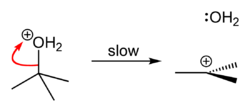Difference between revisions of "Tert-Butanol"
Physchim62 (talk | contribs) (Imported from http://en.wikipedia.org/w/index.php?title=Tert-Butanol&oldid=293875968) |
Physchim62 (talk | contribs) (→References) |
||
| Line 68: | Line 68: | ||
==References== | ==References== | ||
{{reflist}} | {{reflist}} | ||
| + | |||
| + | {{Wikipedia|Tert-Butanol}} | ||
{{alcohols}} | {{alcohols}} | ||
Revision as of 00:06, 16 August 2009
| tert-Butanol[1] | |
|---|---|
| IUPAC name | 2-Methyl-2-propanol |
| Other names | t-Butanol tert-Butanol t-Butyl alcohol tert-Butyl alcohol tertiary-Butyl alcohol 1,1 - dimethylethanol dimethylethanol |
| Identifiers | |
| CAS number | [] |
| SMILES | |
| Properties | |
| Chemical formula | C4H9OH |
| Molar mass | 74.1216(42) g/mol |
| Appearance | colorless liquid, semi-solid or solid |
| Density | 0.78086 g/cm³ |
| Melting point |
25.69 °C, 299 K, 78 °F |
| Boiling point |
82.4 °C, 356 K, 180 °F |
| Hazards | |
| Material safety data sheet (MSDS) | Oxford MSDS |
| NFPA 704 | |
| Except where noted otherwise, data are given for materials in their standard state (at 25 °C, 100 kPa) | |
tert-Butanol, or 2-methyl-2-propanol (colourless liquid or white solid, depending on the ambient temperature), is the simplest tertiary alcohol. It is one of the four isomers of butanol. tert-Butanol is a clear liquid with a camphor-like odor. It is very soluble in water and miscible with ethanol and diethyl ether. It is unique among the isomers of butanol because it tends to be a solid at room temperature, with a melting point slightly above 25 °C.
Preparation
tert-Butanol is derived commercially from isobutane as a co-product of propylene oxide producion. It can also be produced by the catalytic hydration of isobutylene.
Applications
tert-Butanol is used as a solvent, as a denaturant for ethanol, as an ingredient in paint removers, as an octane booster for gasoline, as an oxygenate gasoline additive, and as an intermediate in the synthesis of other chemical commodities such as MTBE, ETBE, TBHP, other flavors and perfumes.
Chemistry
As a tertiary alcohol, tert-butanol is more stable to oxidation and less reactive than the other isomers of butanol.
When tert-butanol is deprotonated with a strong base, the product is an alkoxide anion. In this case, it is tert-butoxide. For example, the commonly used organic reagent potassium tert-butoxide is prepared by refluxing dry tert-butanol with potassium metal.[2]
- K + tBuOH → tBuO−K+ + 1/2 H2
The tert-butoxide species is itself useful as a strong, non-nucleophilic base in organic chemistry. It is able to abstract acidic protons from the substrate molecule readily, but its steric bulk inhibits the group from participating in nucleophilic substitution, such as in a Williamson ether synthesis or an SN2 reaction.
Conversion to alkyl halide
tert-Butanol (also tert-butyl alcohol) reacts with hydrogen chloride to form tert-butyl chloride and water via an SN1 mechanism.
 |
 |
 |
The overall reaction, therefore, is:
Because tert-butanol is a tertiary alcohol, the relative stability of the tert-butyl carbocation in the Step 2 allows the SN1 mechanism to be followed. Primary alcohols generally undergo an SN2 mechanism because the relative stability of a primary carbocation intermediate is very low. The tertiary carbocation in this case is able to stabilize itself better due to electron donation from surrounding sp3 hybridized carbons.
References
- ↑ Merck Index, 11th Edition, 1542
- ↑ William S. Johnson and William P. Schneider β-Carbethoxy-γ,γ-diphenylvinylacetic acid. Org. Synth. 1963, <http://www.orgsyn.org/orgsyn/orgsyn/prepContent.asp?prep=cv4p0132>; Coll. Vol., 4, 132
| See also the corresponding article on Wikipedia. |
| Error creating thumbnail: Unable to save thumbnail to destination | |
This page was originally imported from Wikipedia, specifically this version of the article "Tert-Butanol". Please see the history page on Wikipedia for the original authors. This WikiChem article may have been modified since it was imported. It is licensed under the Creative Commons Attribution–Share Alike 3.0 Unported license. |




